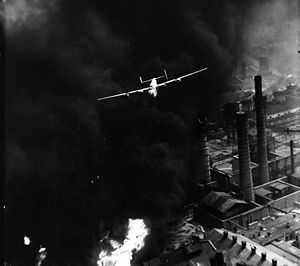
Civilian casualties of strategic bombing
Encyclopedia

| City | Date | Low estimates | High estimates | Attacking force | Notes |
|---|---|---|---|---|---|
| Dresden | 13/02/1945 to 15/02/1945 | 25,000 | 35,000 | British Royal Air Force Royal Air Force The Royal Air Force is the aerial warfare service branch of the British Armed Forces. Formed on 1 April 1918, it is the oldest independent air force in the world... United States Army Air Force |
Fire storm. See Bombing of Dresden in World War II Bombing of Dresden in World War II The Bombing of Dresden was a military bombing by the British Royal Air Force and the United States Army Air Force and as part of the Allied forces between 13 February and 15 February 1945 in the Second World War... . |
| Hamburg | July 1943 | 50,000 | 50,000 | British Royal Air Force Royal Air Force The Royal Air Force is the aerial warfare service branch of the British Armed Forces. Formed on 1 April 1918, it is the oldest independent air force in the world... United States Army Air Force |
Fire storm. See Bombing of Hamburg in World War II Bombing of Hamburg in World War II The Allied bombing of Hamburg during World War II included numerous strategic bombing missions and diversion/nuisance raids. As a large port and industrial center, Hamburg's shipyards, U-boat pens, and the Hamburg-Harburg area oil refineries were attacked throughout the war... . |
| Hiroshima | 06/08/1945 | 90,000 | 140,000 | United States Army Air Force | First atomic bomb used in war. See Atomic bombings of Hiroshima and Nagasaki Atomic bombings of Hiroshima and Nagasaki During the final stages of World War II in 1945, the United States conducted two atomic bombings against the cities of Hiroshima and Nagasaki in Japan, the first on August 6, 1945, and the second on August 9, 1945. These two events are the only use of nuclear weapons in war to date.For six months... . |
| Nagasaki | 09/08/1945 | 73,884 | 80,000 | United States Army Air Force | Plutonium bomb. See Atomic bombings of Hiroshima and Nagasaki Atomic bombings of Hiroshima and Nagasaki During the final stages of World War II in 1945, the United States conducted two atomic bombings against the cities of Hiroshima and Nagasaki in Japan, the first on August 6, 1945, and the second on August 9, 1945. These two events are the only use of nuclear weapons in war to date.For six months... . |
See also
- Aerial bombardment and international lawAerial bombardment and international lawAir warfare, must comply with laws and customs of war, including international humanitarian law by protecting the victims of the conflict and refraining from attacks on protected persons....
- Aerial bombing of citiesAerial bombing of citiesA species of strategic bombing, the aerial bombing of cities began in 1915 during World War I, grew to a vast scale in World War II, and continues to the present day. The development of aerial bombardment marked an increased capacity of armed forces to deliver explosive weapons in populated areas...
- Civilian casualtiesCivilian casualtiesCivilian casualties is a military term describing civilian or non-combatant persons killed, injured, or imprisoned by military action. The description of civilian casualties includes any form of military action regardless of whether civilians were targeted directly...
- Roerich Pact
- Strategic bombingStrategic bombingStrategic bombing is a military strategy used in a total war with the goal of defeating an enemy nation-state by destroying its economic ability and public will to wage war rather than destroying its land or naval forces...
- Terror bombing
- The BlitzThe BlitzThe Blitz was the sustained strategic bombing of Britain by Nazi Germany between 7 September 1940 and 10 May 1941, during the Second World War. The city of London was bombed by the Luftwaffe for 76 consecutive nights and many towns and cities across the country followed...

